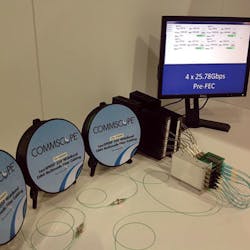In the data center's constant progression toward faster speeds and tighter densities, both the physical footprint and the transmission capability of the network's cabling infrastructure are critical. Recent developments in multimode optical fiber aim to advance both those fronts, and keep multimode a viable, economical media option even as data rates reach 400 Gbits/sec.
The particular technological development that holds such promise is wideband multimode fiber (WBMMF). Just about one year ago - in September 2014 - CommScope engineering fellow Paul Kolesar introduced WBMMF in a post to the company's corporate blog. WBMMF accommodates multiplexing, which is the transmission of signals over multiple wavelengths of a fiber. The most recent generations of multimode fiber, OM3 and OM4, accommodate transmission over a single wavelength window, at and very near 850 nm. WBMMF will widen the operating window to 950 nm (hence the term “wide band”), and through WDM, multiple wavelengths within that 850-950 range will be used separately to carry signal. In simplistic terms, each of the four, 25-nm wavelengths between 850 and 950 may carry 10 Gbits/sec of data, facilitating 40-Gbit/sec transmission over one multimode fiber. Or each may carry 25 Gbits/sec, totaling 100-Gbit/sec transmission over one fiber. Multimode-based WDM deployed over WBMMF will employ a dual-fiber setup, with each fiber supporting transmission in a single direction (i.e. a transmit fiber and a receive fiber).
In his September 2014 blog post, Kolesar explained, “Through wavelength division multiplexing each additional wavelength expands the capacity of the fiber, allowing either a reduction in the number of fibers or an increase in total channel capacity … WBMMF can support four or more wavelengths to significantly improve capacity.”
Until recently, WDM technology had been applied to singlemode fiber exclusively. Singlemode-based WDM components are established and mature, but like WBMMF, multimode-based WDM technology is in development by multiple companies.
A TIA JTG
Kolesar chairs the Telecommunications Industry Association's TR-42.11 engineering committee, which is responsible for standards related to optical systems. Along with the TR-42.12 committee (responsible for fibers and cables), TR-42.11 formed a joint task group (JTG) after the October 2014 commencement of a project to specify wideband multimode fiber. We spoke with Kolesar after the JTG's June 2015 meeting.
CommScope's LazrSpeed 550 WideBand multimode fiber was part of a demonstration that took place in the Finisar booth at the 2015 OFC show.
“TR-42.12 is ultimately responsible for producing the new standard,” he said. “The JTG has met approximately monthly since October 2014, including two face-to-face meetings in February and June. The contribution level has been lively, addressing several relevant topics. At the June meeting, TR-42.12 made a couple important decisions. 1) The JTG will use two specific application channel models for determining fiber parameters, namely the 32G Fibre Channel and 100GBase-SR4 [Ethernet] link model spreadsheets. Satisfying the 32GFC model will fulfill the objective to support at least 28 Gbits/sec per wavelength to at least 100 meters. Satisfying the 100GBase-SR4 model will fulfill the objective to support at least 100 Gbits/sec per fiber to at least 100 meters.
“2) Draft TIA-492-AAAE, as modified at the meeting, shall go out for first ballot in time to close for comment resolution at the next face-to-face meeting in October. Multiple ballots are anticipated before the WBMMF specification is published, meaning that publication will likely be in 2016.”
Other standards activities
Kolesar noted there is no similar WBMMF specification effort taking place within the International Electrotechnical Commission (IEC). “It is planned that when the specification matures sufficiently, a project will be undertaken in IEC 86 to harmonize with the TIA specification,” he said. “These kinds of work-division agreements have happened several times in the past, always with positive outcome. Sometimes IEC takes the lead, and sometimes both IEC and TIA run projects in parallel. The choice is made up front, with an eye toward efficient use of participants' resources and due consideration of the available preparation schedule. When IEC produces a specification, then ISO/IEC can reference it. In this case that may lead to a new OMx designation, following in the footsteps of the popular OM1, OM2, OM3, OM4. For WBMMF it may make the most sense to call it OM4-WB because it is intended to provide the same total bandwidth (modal plus chromatic) as OM4 across a wide band of wavelengths.”
While the TIA is using 32GFC and 100GBase-SR4 as “proving-ground” type channel models for WBMMF's performance parameters, neither the IEEE 802.3 group nor the International Committee for Information Technology Standards (INCITS) is currently developing an application specification that specifically references WBMMF. Kolesar explained that dynamic. “While no formal proposal has surfaced in IEEE for Ethernet or INCITS for Fibre Channel, many companies participating in the WBMMF standardization also participate in those application standards activities. At this point, I'd venture to say that most companies in these groups are aware that work is underway on WBMMF. TR-42 is progressing towards a WBMMF specification with a sense of urgency driven by a desire not to miss the earliest opportunities that arise in these application groups.
“Both of the mentioned application groups require a specification that can be referenced before they will adopt the fiber. In other words, by the time their drafts are nearing publication, they must either have a published WBMMF specification in hand, or be confident that its publication will precede their own. The referenced fiber standard can be from TIA or IEC. Given that new Ethernet and Fibre Channel standards take years to develop, the TIA TR-42 WBMMF specification effort is likely ahead of this timeline, even if the development of these new applications began today.”
Efficient work
He also pointed out that three main transceiver manufacturers - Finisar, Avago, and the former JDSU now called Lumentum - are participating in the WBMMF standardization effort. Some multimode-WDM transceivers have already reached the market, including those used in Cisco's 40-Gbit/sec BiDi system, and other such transceivers are currently sampling. “While there are differences in how the wavelengths are employed, their existence illustrates that VCSEL-based WDM technology can be specified,” Kolesar said.
Along with cooperative participation from transceiver manufacturers, another reason the WBMMF standard appears to be on a fast track to finalization is that the JTG has been able to leverage some of the efforts made years ago when other fiber parameters were determined. For example, the bandwidth-characterization methods DMD (differential mode delay) mask and minEMBc (minimum effective modal bandwidth calculated) were developed during the standardization process for OM4 fiber. The TIA JTG being spared the development of a bandwidth-characterization method is one time-saver, and the group is making moves to make the WBMMF standardization process even further efficient. “In order to expedite the development of the WBMMF specification, the JTG has agreed to boil down the effective modal bandwidth specification to a single metric instead of two,” Kolesar explained. “The fundamental measurement remains DMD. Due to the interaction of the waveguide with the different wavelengths, the development of a DMD Mask specification would require a full-blown simulation effort many months in duration. To save this time, instead we decided to just use the minEMBc metric. It can be applied without full simulations because the WDM transceiver makers have agreed to continue to conform to the same launch conditions that have been in place since 2002. That means the existing 10 EMBc weight sets, which represent 10 different laser launch conditions, still apply across the wavelength band of interest, allowing straightforward application of the minEMBc calculations using DMD data measured at longer wavelengths.”
One potential snag in the to-date rapid development of a WBMMF specification is that an effort sanctioned by IEC 86 is underway to “review the state of the industry with regard to measurements of fiber chromatic dispersion properties,” Kolesar explained.
Dispersion is the spreading of light pulses as they travel along an optical fiber; this spreading degrades the signal being transmitted. Chromatic dispersion and modal dispersion can affect transmission, are specified in standards, and are related to each other. Chromatic dispersion results from the fact that in VCSEL-based transmission, pulses are generated at multiple wavelengths, all very near 850 nm. Nonetheless, the use of different wavelengths results in this type of pulse spread. Modal dispersion results from the fact that multiple modes, or paths, of light travel down a fiber's core (hence the term “multimode”). These paths or modes of light have slightly different lengths from each other, causing this type of pulse spread.
The physics behind chromatic dispersion, as well as the relationship between chromatic dispersion and modal dispersion, are worthy of an entire whiteboard in a classroom. But Kolesar summed it up by stating that a possible outcome of the IEC's current review of chromatic dispersion property measurement is a reduction of chromatic dispersion. Reduced chromatic dispersion would increase chromatic bandwidth. “If completed in time, any reduction in chromatic dispersion limits will be reflected in the WBMMF specification.” He added that such a tightening up of chromatic dispersion requirements would be accompanied by a corresponding loosening of modal dispersion requirements.
Certainly the TIA's TR-42.11 and 42.12 JTG is closely watching the IEC's investigation. We also will keep tabs on the development of TIA-492-AAAE, as well as the commercial development of new WDM technologies, and keep you apprised of their progress.
Patrick McLaughlin is our chief editor.


